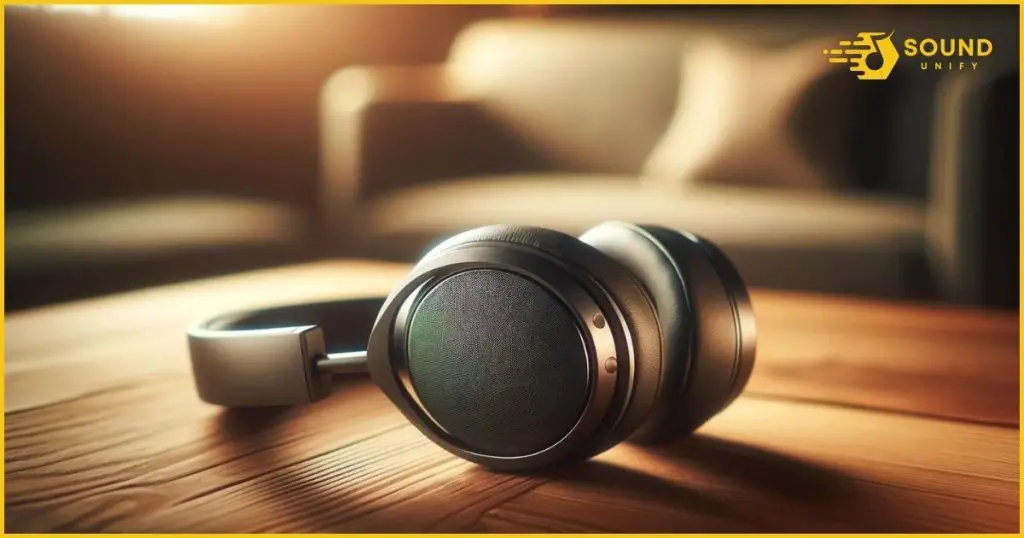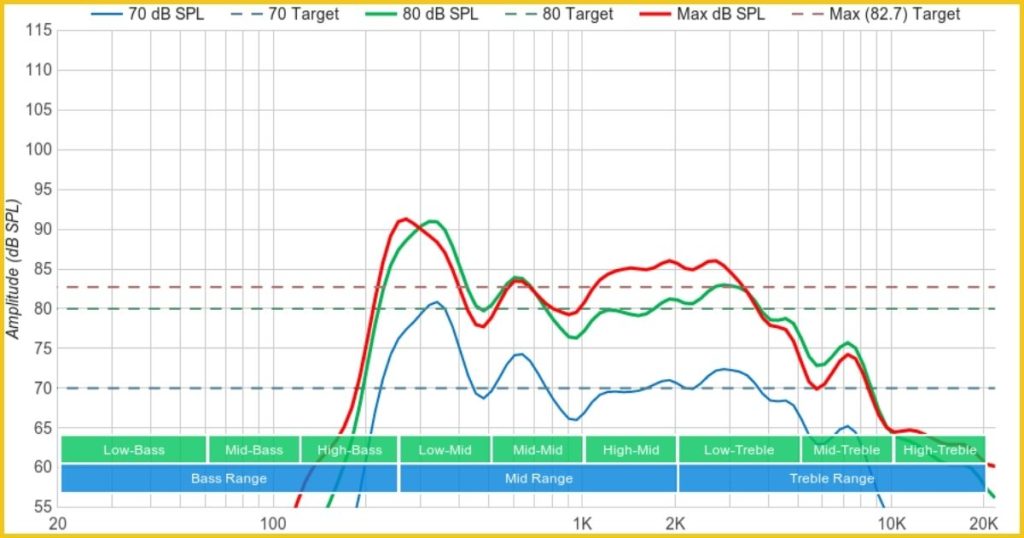When it comes to headphones, we often hear the term “frequency response” being mentioned. But what exactly does frequency response mean, and why is it important?
This blog will dive deep into headphone frequency response and explore its significance in understanding sound quality and audio reproduction.
Whether you’re a casual music listener or an audiophile, understanding frequency response will help you choose headphones that suit your preferences and listening needs.
Read more: Learn About Headphones
Understanding the Basics of Frequency Response

Before we delve further into headphone frequency response, let’s first grasp the basics of frequency response itself.
In simple terms, frequency response refers to how well a headphone can reproduce sound across different frequencies. It measures a headphone’s ability to accurately reproduce frequencies, from lower bass notes to higher treble frequencies.
Sound waves, as we know, are made up of different frequencies, and our ears can perceive sound within a specific range called the audible frequency range.
The audible frequency range for humans typically spans from 20 Hz (hertz) to 20 kHz (kilohertz). So, headphones with a frequency response covering this entire range can reproduce the full spectrum of sound our ears can hear.
Definition and Importance of Frequency Response in Headphones
Now that we have a basic understanding of frequency response, let’s look at its definition and importance, specifically in the context of headphones.
Frequency response in headphones is measured and represented by a frequency response graph, which shows how a headphone responds to different frequencies.
This graph displays the sound amplitude at each frequency, allowing us to visualize how a headphone emphasizes or attenuates specific frequencies.
The frequency response of a headphone plays a crucial role in determining the overall sound quality. A balanced frequency response ensures that all frequencies are reproduced accurately, producing a natural and well-rounded audio experience.
On the other hand, headphones with uneven frequency responses may introduce distortions, colorations, or a tonal imbalance. That can negatively impact sound reproduction.
When we listen to music or other audio content, our hearing system expects a particular frequency response curve based on real-life sound sources, such as instruments or human voices.
If a headphone’s frequency response deviates significantly from this expectation, the resulting sound may sound unnatural or unfaithful to the original recording.
Therefore, understanding and considering a headphone’s frequency response is essential in selecting headphones that meet your sound quality preferences.
Whether you prefer flat frequency responses for accurate sound reproduction or headphones with a more emphasized bass or treble response for a particular music genre, frequency response provides valuable insights into a headphone’s sound signature.
The Standard Frequency Range for Headphones
Now that we understand the importance of frequency response, let’s explore the standard frequency range for headphones. The frequency range refers to the range of frequencies that a headphone can reproduce.
Most headphones, designed for a wide range of audio applications, aim to cover the audible frequency range of human hearing, which spans from 20 Hz to 20 kHz.
Within this range, lower frequencies, such as deep bass notes, sit towards the lower end of the spectrum, while higher frequencies, such as cymbals or vocals, occupy the upper back.
By encompassing this standard frequency range, headphones ensure that they can reproduce a wide variety of audio content, including music, movies, podcasts, and more, with fidelity and accuracy.
Beyond the Standard Range: Expanded Frequency Responses

While the standard frequency range of 20 Hz to 20 kHz covers the majority of audible frequencies, some headphones offer expanded frequency responses, extending beyond this range.
This developed frequency response allows headphones to reproduce even lower bass frequencies or higher treble frequencies, pushing the boundaries of audio reproduction.
By enhancing the bass response, headphones with expanded frequency responses provide a more robust and immersive audio experience. It is particularly suitable for bass-heavy genres like electronic music or hip-hop.
Similarly, headphones with extended treble frequencies can reproduce delicate details and harmonics, producing more nuanced and detailed sound representation.
How do Expanded Frequency Ranges Impact Sound Quality?
The impact of expanded frequency ranges on sound quality is a topic of interest for audiophiles and music enthusiasts.
A wider frequency response range can improve sound quality, particularly in reproducing bass frequencies and treble response.
When headphones can faithfully reproduce lower bass frequencies, the audio signal becomes more immersive and engaging, with a sense of power and rumble.
This is especially important when listening to genres like EDM or orchestral music, where deep bass notes are crucial to the overall sonic experience.
On the other hand, extended treble response opens up a new level of detail and clarity in sound reproduction. Headphones capable of reproducing higher treble frequencies can better capture the subtle nuances of instruments, vocals, and ambient sounds, adding realism to the audio.
To fully appreciate the impact of expanded frequency ranges on sound quality, it is essential to consider the overall quality and design of the headphones. Including:
- Drivers
- Amplification
- Audio processing
These factors and the frequency response create a rich and immersive audio experience.
Examples of Headphones with Expanded Frequency Response
Several headphones in the market are known for their expanded frequency response capabilities, offering audiophiles and audio enthusiasts a wide range of options.
Here are some well-regarded headphones that excel in reproducing a broad range of frequencies:
- Sony WH-1000XM4: Featuring a frequency response range of 4 Hz to 40 kHz, the Sony WH-1000XM4 delivers exceptional audio quality, capturing both deep bass frequencies and detailed treble response.
- Audeze LCD-4: Renowned among audiophiles, the Audeze LCD-4 boasts an impressive frequency response range of 5 Hz to 50 kHz, capturing the subtlest details in sound across the entire frequency spectrum.
- Sennheiser HD 800 S: With a frequency response range of 4 Hz to 51 kHz, the Sennheiser HD 800 S offers a balanced audio signature, reproducing bass frequencies, upper frequencies, and everything in between with exceptional clarity.
- Beyerdynamic DT 1990 Pro: Known for its analytical sound signature, the Beyerdynamic DT 1990 Pro features a frequency response range of 5 Hz to 40 kHz, delivering a precise and accurate sound representation.
Frequency Response and the Role It Plays in Sound Pitch

Sound pitch refers to the perceived frequency of a sound, determining whether it sounds high or low to our ears.
Frequency response plays a significant role in sound pitch accuracy, as headphones with a flat and consistent frequency response ensure that each frequency is reproduced accurately.
When a headphone’s frequency response curve deviates significantly, it can lead to slight differences in sound pitch, potentially altering audio content’s overall tonal balance and timbre.
Correlation Between Frequency Response and Sound Pitch
The correlation between frequency response and sound pitch is crucial to understanding how headphones reproduce different frequencies accurately and perceptually.
Let’s delve deeper into this correlation and explore its implications on sound quality.
The frequency of a sound wave primarily determines sound pitch. Higher frequencies, such as those associated with treble frequencies, are perceived as higher pitched, while lower frequencies, like bass frequencies, sound lower pitched.
Sound pitch accuracy is maintained when headphones possess a flat frequency response, meaning they can reproduce all frequencies equally.
However, if a headphone’s frequency response curve deviates, specific frequencies may be emphasized or attenuated, leading to slight differences in sound pitch perception.
For example, headphones with a pronounced bass response may emphasize lower frequencies. This resulted in a perceived boost in bass-heavy music genres. Similarly, headphones with a brighter treble response may highlight higher frequencies, adding crispness and sparkle to vocals and instruments.
By understanding the correlation between frequency response and sound pitch, listeners can choose headphones that suit their preferred sound signature.
How Different Frequencies Affect Sound Pitch?
Different frequencies within the audible spectrum distinctly impact sound pitch perception. Let’s explore how lower and higher frequencies affect sound pitch and tonal balance.
Lower or bass frequencies typically range from 20 Hz to approximately 250 Hz. These frequencies create a sense of depth and richness in audio, particularly in bass-heavy genres like electronic music or hip-hop.
When headphones reproduce lower frequencies accurately, listeners can experience a satisfying and immersive bass response. This adds depth and impact to their audio content.
On the other hand, higher frequencies, also referred to as treble frequencies, span from approximately 2 kHz to 20 kHz. These frequencies give clarity, detail, and presence, making vocals, instruments, and ambient sounds shine.
Headphones that accurately reproduce higher frequencies allow listeners to perceive the delicate nuances and harmonics in audio recordings—resulting in a more refined and engaging listening experience.
The interplay between lower and higher frequencies and midrange frequencies shapes the overall tonal balance of audio content.
A balanced frequency response across the entire spectrum ensures accurate sound reproduction, allowing listeners to hear audio as intended by the creators.
Decoding Frequency Response Numbers
When researching headphones, you may encounter various frequency response numbers, often expressed in hertz (Hz) or decibels (dB). But what do these numbers signify, and how can we decode them to understand a headphone’s performance better?
Frequency response numbers indicate the range of frequencies a headphone can reproduce. The lower frequency number represents the lower limit, while the higher frequency number signifies the upper limit of a headphone’s frequency response range.
For example, a frequency response range of 20 Hz to 20 kHz means a headphone can accurately reproduce frequencies from 20 Hz, the lower bass range, to 20,000 Hz, the upper treble range.
Decibels, denoted as dB, are used to measure sound pressure levels. In the context of frequency response, decibels can represent the level of a specific frequency relative to a reference level.
For example, a headphone may have a deviation of ±2 dB at a particular frequency, indicating that the sound output at that frequency may vary by a maximum of 2 decibels from the reference level.
The Truth about Frequency Response Numbers
The frequency response numbers can help us understand a headphone’s audio performance. But it’s essential to distinguish the truth behind these numbers from potential misconceptions.
Frequency response numbers, typically indicated in hertz (Hz), describe the frequencies a headphone can accurately reproduce.
These numbers provide a general idea of a headphone’s frequency range. It allows users to assess whether it covers the audible spectrum of human hearing.
However, frequency response numbers alone do not guarantee perfect sound reproduction. They depict a headphone’s frequency range but not its tonal balance, sound signature, or other sound quality factors.
Another aspect to consider is the deviation, often specified as ±dB, within a headphone’s frequency response range. This deviation represents the maximum level of variation from a reference level at different frequencies.
For instance, a deviation of ±2 dB suggests that the sound level at a given frequency may vary by a maximum of 2 decibels, either above or below the reference level.
It’s essential to note that frequency response measurements are conducted in controlled environments and may not perfectly represent real-life listening scenarios. A headphone’s fit, ear canal resonance, and ambient noise can influence the perceived frequency response. This results in slight differences from laboratory measurements.
Therefore, while frequency response numbers provide valuable information about a headphone’s frequency range, they should be considered alongside other factors. Such as:
- Sound signature
- Sound quality
- Ergonomic design
- Personal listening preferences
Why Frequency Response Numbers Can Be Deceptive?
While frequency response numbers can provide a general understanding of a headphone’s sound characteristics, they can also be deceptive if not correctly interpreted. Let’s explore why frequency response numbers may not always tell the complete story about a headphone’s performance.
- Controlled Conditions vs. Real World: Frequency response measurements are typically carried out in lab settings under ideal conditions. This precision is hard to replicate outside the lab, meaning your real-world experience may diverge from those neat numbers on the spec sheet.
- The Personal Touch: Our ears are unique, and so are our preferences. One person’s audio nirvana might be another’s noise nightmare. A flat response might appeal to purists seeking accuracy, but others might crave a boost in bass or a sparkle in the treble for a more vibrant listening experience. Numbers can’t predict personal taste.
- The Fit Factor: The perfect seal is a myth for many. From the shape of your outer ear to the presence of glasses or earrings, several factors can disrupt the ideal fit, altering the sound you hear. A slight gap or shift can change everything.
- Room for Interpretation: Lastly, frequency response numbers, often depicted as a range (e.g., 20 Hz – 20 kHz), don’t detail how evenly a headphone reproduces sounds across that spectrum. Peaks and dips in certain areas can color the sound in ways that numbers alone can’t capture.
It’s important to remember that frequency response measurements quantitatively represent a headphone’s sound reproduction capabilities. Still, they may not entirely depict the subjective experience of listening to music or audio content.
The Plus/Minus Deviation in Frequency Response
When examining a headphone’s frequency response specifications, it’s common to encounter the terms “plus/minus deviation” or “±dB.” These terms describe the level of variation a headphone may exhibit within its frequency response range.
Understanding ±dB in Frequency Response
The ±dB notation in frequency response measurements provides valuable information about a headphone’s sound characteristics and variation level.
Deviation, represented by ±dB, refers to the variation a headphone’s sound level might experience at various frequencies compared to a reference level. Positive deviation indicates that the sound level may be higher than the reference level, while negative deviation suggests that it may be lower.
This deviation allows us to understand how headphones may emphasize or attenuate specific frequencies, resulting in a perceptible sound signature.
For example, a headphone with a positive deviation at higher frequencies may sound brighter or more detailed. In comparison, a negative deviation in lower frequencies may result in a less pronounced bass response.
It’s important to note that deviation measurements involve sound pressure level (SPL), representing the amplitude of sound waves. Positive deviation translates to a higher SPL than the reference level, while negative deviation indicates a lower SPL.
Impact of Deviation on Sound Quality
Deviation in a headphone’s frequency response measurements can significantly impact sound quality, particularly regarding tonal balance, bass response, and sound reproduction fidelity.
A headphone exhibiting a specific deviation at various frequencies may introduce tonal imbalances by emphasizing or attenuating particular frequency ranges.
For example, a headphone with a deviation that emphasizes the bass frequencies may result in a sound signature tilted towards bass-heavy reproduction, affecting the overall tonal balance. Similarly, a deviation that boosts treble frequencies can lead to a sound signature perceived as brighter or more detailed.
Bass response is often a critical factor in sound quality evaluation. Deviation in bass frequencies can significantly affect how headphones reproduce low-frequency sounds. This impacts the overall audio experience, especially in genres that rely heavily on deep bass, such as electronic music or rap.
Therefore, when choosing headphones that suit your listening preferences, understanding the impact of deviation and how it influences sound quality is essential. Whether you prefer a balanced frequency response, a bass-emphasized response, or a treble-focused sound signature, considering deviation measurements can guide you toward headphones that align with your desired sound characteristics.
Interpreting the Frequency Response Graph

One of the common ways of representing a headphone’s frequency response is through a frequency response graph. This graph visually represents a headphone’s response to different frequencies. Also, it allows users to interpret the headphone’s sound characteristics and tonal balance.
Critical Elements of a Frequency Response Graph
A frequency response graph captures a headphone’s sound characteristics across the audible frequency range. The graph provides valuable insights into its tonal balance and frequency reproduction accuracy. Let’s explore its essential elements to understand a frequency response graph better.
Horizontal Axis – Frequency (Hz):
- This axis stretches from the deep, rumbling low frequencies (20 Hz) to the sharp, sizzling high frequencies (20 kHz).
- It acts as a map, guiding us through the varied landscape of sound, allowing the identification of which frequencies are given prominence or softened.
Vertical Axis – Amplitude (dB):
- Here, we measure the loudness at each frequency, with the unit being decibels (dB).
- It’s like the graph’s heartbeat, showing how vigorously or gently a headphone treats each frequency. Peaks and valleys on this axis reveal the headphone’s sound character.
The Graph Line – The Sound Signature:
- A flat line across this graphical journey suggests an egalitarian approach: no frequency outshines another, heralding a neutral sound signature.
- Conversely, peaks and dips narrate a story of selectivity, highlighting specific frequencies over others. This creates a unique sound profile tailored to specific genres or preferences.
Understanding the critical elements of a frequency response graph helps us visualize a headphone’s sound characteristics, tonal balance, and deviation from a flat frequency response. It helps our decision-making when selecting headphones that best align with our audio preferences.
Misconceptions Surrounding Frequency Response Graphs
While frequency response graphs provide valuable insights into a headphone’s sound characteristics, tonal balance, and frequency response, some misconceptions can arise when interpreting these graphs.
Let’s address a few common misconceptions surrounding frequency response graphs.
- Flat Line Expectation: Many believe a perfectly flat line represents the ideal frequency response curve. However, slight deviations are normal and desirable, reflecting design choices and user preferences. A flat response isn’t the only hallmark of quality sound.
- Compensated Graphs Misinterpretation: Compensated frequency response graphs are designed to account for ear canal resonance and pinna gain, aiming to mirror what listeners perceive. Yet, some misinterpret them as standard measurements, missing their nuanced purpose. These graphs offer a more accurate representation of a headphone’s sound signature, not less.
It’s essential to approach frequency response graphs with a holistic understanding of headphone measurements. Sound system design and personal taste in sound signature.
By recognizing the limitations and nuances, frequency response graphs can be valuable tools for evaluating headphone performance and tonal balance.
The Concept of “Flat” Response in Headphones
A “flat” frequency response is often touted as an ideal characteristic in headphones. This promises accurate sound reproduction and balanced audio quality. Let’s explore the “flat” response concept in headphones:
What Does a “Flat” Response Mean?
A “flat” frequency response in headphones is a response curve that resembles a straight line on a frequency response graph. This means the headphone reproduces all frequencies equally without emphasizing or attenuating any particular frequency range.
A flat frequency response reflects a tonal balance where no frequency range is overemphasized. The result is a neutral, unaltered sound reproduction.
This tonal balance is often favored by sound professionals, audio engineers, and music enthusiasts who prioritize accuracy, clarity, and faithful sound reproduction.
Headphones with a flat frequency response aim to provide a transparent listening experience where audio content is reproduced as close to its original recording as possible.
This allows listeners to perceive the audio content in its purest form, without colorations or alterations introduced by frequency response variations.
Is a Flat Response Always Desirable?
A flat frequency response, often hailed as the epitome of accurate sound reproduction, might not tick all the boxes for every audiophile or casual listener.
Why, you ask? The answer lies in the complex interplay of personal preferences, music genres, and the unique characteristics of each listener’s ears.
- Personal Taste is King: One size does not fit all when enjoying music. Some of us are all about that bass, craving the thump and rumble that brings electronic beats to life. Others might seek the clarity and shimmer of heightened treble frequencies, making classical compositions sparkle. A deviation from flat can mean a custom fit for your ears.
- Music Genre Matters: Not all tunes are created equal. The pounding beats of hip-hop and the smooth basslines of electronic music often demand a bass boost, transforming good tracks into great ones. Conversely, the intricate harmonies of classical music and the nuanced vocals of singer-songwriter genres shine brightest with a flat response, revealing the artistry in every note. Different strokes for different folks (and tracks!).
Table: Genre vs. Preferred Frequency Response
| Music Genre | Preferred Frequency Response |
|---|---|
| Electronic, Hip-Hop | Slight Emphasis on Bass |
| Classical, Vocal | Flat Response |
| Rock, Pop | Balanced, with a slight lean toward the listener’s preference |
Does a Good Frequency Response Guarantee Excellent Sound Quality?

While a good frequency response is integral to sound quality, it alone does not guarantee an excellent audio experience. Let’s explore why a good frequency response is vital to sound quality and other factors contributing to exceptional audio reproduction.
- More Than Just Frequencies: A headphone’s ability to faithfully reproduce a wide range of frequencies, from the deep bass to the shimmering highs, is critical. It means the music comes through as the artist intended, rich in detail and nuance. But that’s not the whole story.
- The Role of Drivers: Think of drivers as the heart of your headphones. The quality of these components can make or break your audio experience. High-quality drivers deliver clarity, depth, and a dynamic soundstage, bringing every track to life.
- The Art of Tuning: Manufacturers don’t just throw in good drivers and call it a day. Headphone tuning is an art form. It’s about shaping the sound signature to enhance certain audio qualities, whether warm bass or crisp highs, catering to diverse preferences and genres.
- Tech Enhancements: Modern audio processing technologies, like signal equalization and digital sound processing, are the unsung heroes of sound quality. They refine and polish the audio, ensuring a balanced, immersive listening experience that complements the headphone’s inherent frequency response.
- System Synergy: Lastly, the ecosystem surrounding your headphones – the amplifier, audio source, and file quality – plays a crucial role. A great pair of headphones with a matching amplifier and high-resolution files can transform good sound into an extraordinary audio journey.
Furthermore, sound system design affects sound quality, including the headphone amplifier, audio source quality, and audio files.
Combining headphones with a well-matched amplifier, audio player, and high-resolution audio files can elevate the sound quality to its full potential, maximizing the benefits of a good frequency response.
FAQs
What is a good frequency response for headphones?
A good frequency response for headphones typically ranges from 20 Hz to 20 kHz, covering the full spectrum of human hearing. This range ensures that headphones can accurately reproduce bass frequencies as low as 20 Hz and treble frequencies up to 20 kHz.
Is 20Hz to 20kHz good for headphones?
A headphone’s ideal frequency response range falls between 20Hz and 20kHz, covering the entire audible spectrum. This range ensures balanced audio for listeners by reproducing bass frequencies as low as 20Hz and treble frequencies up to 20kHz.
What is a good frequency response?
A favorable frequency response for headphones typically covers 20 Hz to 20 kHz, encompassing the human hearing range. When headphones offer a flat response, they reproduce sound accurately across all frequencies, providing a balanced listening experience. Wider frequency ranges capture finer details in sound for higher-quality audio.
Does frequency response matter in headphones?
Frequency response is crucial for headphones as it signifies the frequencies they can reproduce accurately. A broader range often implies better sound fidelity. Nevertheless, factors such as driver quality and tuning also impact audio quality. When selecting headphones, consider frequency response alongside other specs for your preferred sound signature.
Is 15000 Hz good for headphones?
A headphone’s 15000 Hz frequency response is ideal, capturing a broad spectrum of audible sounds. Higher frequency ranges enhance sound precision. Consider driver quality and design when choosing headphones based on your audio preferences.
How do I know my headphone frequency response?
To determine your headphone’s frequency response, refer to the manufacturer’s specifications for the frequency range. Utilize online tools or software to measure response. Test with various audio tracks of different frequencies for evaluation. Understanding this helps identify your headphones’ sound characteristics.
Conclusion
Understanding the concept of frequency response is crucial when choosing the right headphones for your audio needs. It determines the range of frequencies that the headphones can reproduce, ultimately impacting the sound quality and clarity.
While a wider frequency range may seem impressive, it doesn’t guarantee excellent sound quality. Factors like distortion, accuracy, and personal preference also come into play.
So, when evaluating frequency response numbers, take them with a grain of salt and consider other aspects too.
Additionally, don’t overlook the significance of a “flat” response. It refers to a frequency response that doesn’t amplify or attenuate specific frequencies, resulting in a more accurate and balanced sound reproduction.
Remember, finding the perfect headphones involves considering various factors, including frequency response, but it ultimately comes down to your taste. If you have any questions or want to share your thoughts on headphone frequency response, feel free to comment below.
James Dimento is a Chief-in-Editor of SoundUnify. He is a headphone enthusiast and creative writer passionate about audio technology. He has three years of experience writing about headphones and sound quality and is responsible for creating reviews and taking care of all administration.
